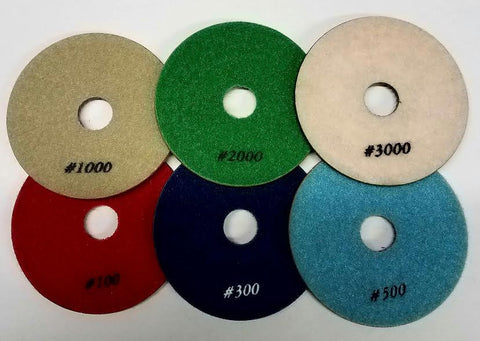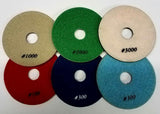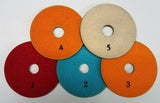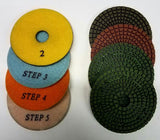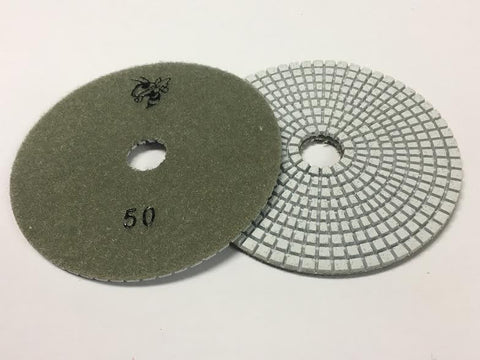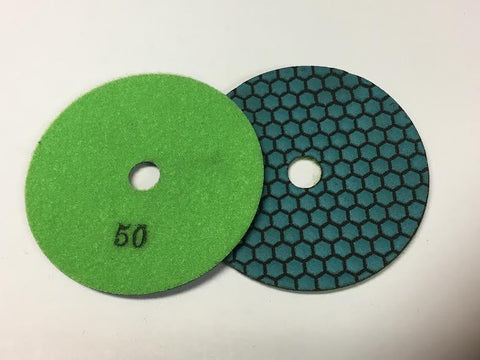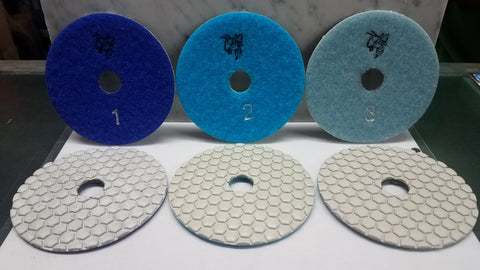Set of Wet Polishing Pads
Polish Stones like a PROFFESSIONAL!!
Diamond polishing pads can be applied to granite polishing, marble polishing and concrete polishing. We offer a complete line of diamond polishing pads for different applications. Wet resin bond diamond polishing pads are generally ideal for polishing granite and marble in stone shops. They are also used for wet polishing of concrete countertops. Dry diamond polishing pads are used on job sites for polishing marble and granite, while our dry diamond polishing pads are widely used for dry polishing of concrete floors and countertops. Metal bond diamond polishing pads are more aggressive. They are used for wet polishing of hard granite and concrete. We also offer special types of diamond polishing pads including diamond polishing pads for engineered stones, electroplated diamond polishing pads for fast removal of material on concrete.Our white resins are desiged specifically for white and light colors.
- Flexible, durable design offers longer life
The pads you have contain diamonds embedded in the resin. Running them against abrasive surfaces such as granite and concrete will file down the resin and expose the diamonds. If you need to polish glass then you will need to expose the diamonds by running them on concrete or ceramic surfaces before using them on glass. These pads are hard for soft stones like marble, travertine, and other limestone so you can only use up to grit #400 wet for these soft stones. Then you can continue dry with higher grits to make the stone shine.
The pads work with a Velcro holder most having 5/8-11 standard thread. This will fit any standard polishers except the very old Makita polishers or certain metric polishers made for Europe. It will also fit highspeed grinders, but DO NOT USE WITH FIXED SPEED HIGH SPEED GRINDERS. Depending on size, 4” wet pads work best at 5000 rpm max. Get a heavy duty dimmer switch to use in-line with a grinder if you don’t want to buy a variable speed one.
Mount a Velcro holder to your tool and then mount a pad to it. Shake the pad in two different directions to interlock the Velcro. If the pad becomes imbalance, stop and remount the pad properly before continuing. Use more water with lower grit and less and less to no water with higher grit. You can also use these pads completely dry, but you’ll need to move the polisher around more quickly to dissipate heat. Grit #50 and #100 are for rough cutting and coarse grinding. If you need to remove lot of material such as filing down concrete to expose aggregates, then we recommend starting with a diamond grinding cup first. Grit #200 will remove big scratches; grit #400 will remove small scratches so if your surface is already smooth then you can start with grit #200. Since scratches are not visible when the surface is wet, a neat trick is to use color crayon pencils to mark those scratches and polish until those markings are gone. If you polish long enough, you will notice a difference in sound when a certain pad is done with an area. Constantly move the polisher around when polishing to avoid scoring a circular pattern into the stone especially with lower grits.
Granite and concrete are porous so to make them shine we recommend at least one round of treatment after polishing with grit #800. We Recommend a Enhancing sealer, such as Tenax Ager. Without the treatment, surfaces may not shine any better than #800 especially concrete. This treatment forms natural stones with granite and concrete giving them a permanent seal. After treatment, continue polishing with higher grits. After polishing with grit #1500, you will see the surface shines and reflects (without water), if not then additional treatment is needed. Buffing pads are designed for final polishing and filling microscopic pores on the surface with their resin so select the dark or light buffing pad depending on the color of your surface. Start with a little bit of water and then buff it dry. You can also buff on a layer of beeswax occasionally. Tips and Tricks: Move the polisher around more quickly when you polish dry to dissipate heat. After polishing with grit #1500 you should see the surface reflect, otherwise it won’t shine any further with higher grit.
We Also Recommend

